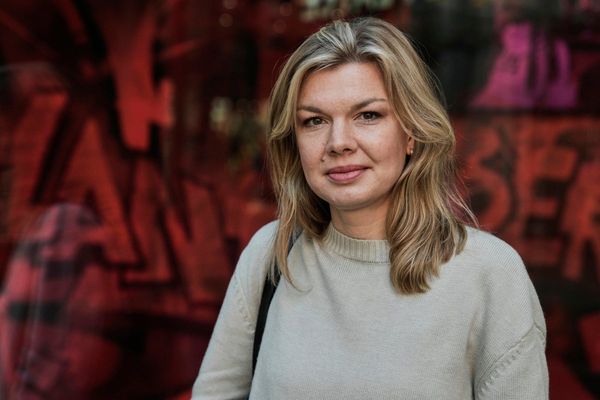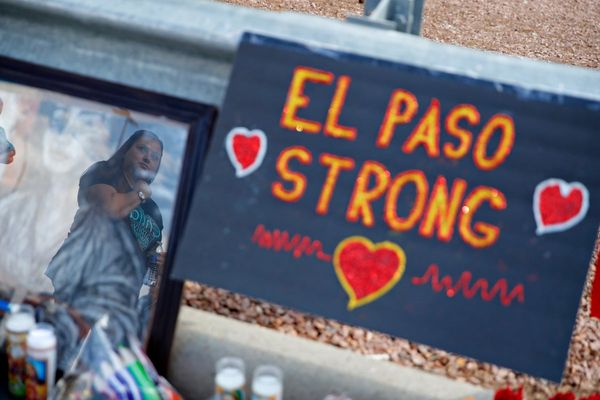Ade Murkey remembers everything about his NBA debut. He recalls what music he was blasting en route to the Kings’ Golden 1 Center: Lil Durk and Lil Baby. What his pregame meal consisted of: salmon and rice. The nerves he felt after learning the team had chosen him—a rookie guard who signed a 10-day contract earlier that day because several Sacramento players were in the league’s COVID-19 health and safety protocols—to wish the home crowd happy holidays before the game.
But most of all, Murkey remembers anxiously looking up at the scoreboard on Dec. 22, 2021, as the Kings trailed the Clippers by double digits late in the fourth quarter, wondering whether the game’s time and score would allow for interim coach Doug Christie to put him in. The 24-year-old had worked his entire life for this chance, his chance. With 1:28 to go and Sacramento down by 15, Murkey heard his name called. He raced off the bench, took the court and, as he puts it, got “a few up-and-downs in.” He never touched the ball, but he enjoyed every second of it.
“That was a memory of a lifetime, for sure,” Murkey says.
A few days later, Murkey was back to life in the G League, playing for the Stockton Kings with the hope of returning to the Association one day. But if he never steps foot on an NBA court again, he will always be part of a select group of players: the NBA’s One-Minute Club.
According to Basketball Reference, coming into this season only 10 players had logged one minute or less throughout their entire NBA careers (though it should be noted, like in the case of Murkey, the site rounds on-court stints between 60 and 90 seconds down to a single minute). As of mid-January, the group had grown to 14 during a season that has seen a record number of contributors due to the pandemic. Those in the club have been left to wrestle with their careers being the shortest in the league’s 75-year history. Some stuck with basketball while others moved on to other professions. But all of them can forever note the same thing: They appeared in an NBA game. Just like Kareem Abdul-Jabbar, who logged a record 57,446 minutes throughout his 20-year career. Just like Wilt Chamberlain, who once averaged 48.5 minutes per game in a single season.

Illustration by Davide Barco
Their NBA careers may have lasted only a matter of seconds, but their stories—of getting their big break, of sharing locker rooms with All-Stars, of standing on the sport’s biggest stage—will endure for generations.
“Growing up, everybody’s dream is to touch the NBA court, to play in the NBA,” says Murkey. “It means everything.”
In the annals of the NBA record book, there are countless mentions of Michael Jordan and Magic Johnson, LeBron James and Steph Curry. But, in the smallest of fine print, there is also Cedric Hunter. In December, the former guard found himself watching a Celtics-Warriors game with one of his twin 11-year-old boys, Trenton, who wanted to know the answer to the age-old debate: Who is the greatest NBA player of all time?
Hunter, 57, replied that people have different opinions. But his son, not satisfied, pushed his father further: “Were you better than Michael Jordan?” Hunter, amused by the question, responded: “No. Michael Jordan was on a whole different level.”
Hunter was the starting point guard at Kansas during the team’s 1985–86 Final Four season. He went on to star in the Continental Basketball Association and, on Feb. 14, 1992, got a call from his coach with the Omaha Racers, Mike Thibault (now the GM-coach of the WNBA’s Mystics). With Rex Chapman out with a foot injury, the Charlotte Hornets needed a point guard and wanted to sign Hunter to a 10-day contract.

Illustration by Davide Barco
Two days later Hunter made his NBA debut, playing one minute—technically 48 seconds, he makes sure to clarify—in garbage time of a 17-point win over the Heat. Hunter finished the game, and his NBA career, without any counting stats. “Man, I should have just fouled somebody,” he jokes. All he kept from his NBA days—and it was just that, a few days—was a practice T-shirt and a matching pair of shorts.
After his stint, Hunter went back to the CBA and eventually resettled in the Omaha area, where he is currently a behavioral interventionist at Boys Town Day School, working with high school students who are temporarily pulled out of class. It’s a job he takes great pride in; he credits his experience as a point guard for developing his ability to effectively communicate with different types of people.
Hunter doesn’t bring up his basketball career to his students. But he’s grown accustomed to them Googling his name and asking questions—which he uses as a teaching lesson: “It’s not about the destination,” he says. “It’s about the journey.”
Forest Able can relate. Able was a third-round pick by the Syracuse Nationals in the 1956 draft, taken 19 spots after Bill Russell, the No. 2 selection. Russell, of course, went on to a long and successful NBA career, logging more than 40,000 minutes and winning 11 championships as a player. Able, a 6' 3" guard from Western Kentucky, played one minute in one game.
Able is credited with taking two shots, grabbing one rebound and dishing out a single assist in a 16-point victory over the Rochester Royals, his lone appearance coming in the season’s second game. But Able has a different recollection.
Now 89, he remembers being “a nervous wreck” and the ball being stolen away the first time he touched it. When Syracuse regained possession following his turnover, Able recalls the team’s coach, Al Cervi, taking a timeout and pulling him. He was released shortly after his debut. “They knew I wasn’t gonna make it,” Able says.
He returned home to Fairdale, Ky., and worked at the local high school. Able taught physical education and health for 30 years. He coached basketball for more than a decade. And, for 21 years, he drove a school bus, staying connected to the sports scene through conversations with his youthful passengers.

Illustration by Davide Barco
His son Todd says they didn’t talk much about his father’s professional career growing up—more so his college achievements—but his family still takes pride in it. “How many people do you know who have played in the NBA?” Todd Able asks. “We’re from this small town. I mean, it just doesn’t happen.”
Adds Hunter, who would join Able in the club nearly four decades later: “Think of how many people didn’t get that opportunity. The list of NBA players isn’t as long as you think. And you’re a part of that group.”
Trey McKinney-Jones wants to make something clear about his NBA career: Despite logging 74 seconds—the Guinness World Record time for juggling five basketballs—it was not a failure. Sure, the guard acknowledges, it “didn’t go the way people kind of see it growing up,” but he’s learned to appreciate the life experiences that have come from his odyssey.
After going undrafted out of Miami in 2013, McKinney-Jones spent the next few years pinballing between the G League (then the D-League) and overseas opportunities. His first international stop was in France in ’14, where he recalls once asking a coach about what happens if someone is too homesick to play. “Looking back, that was the silliest thing to do,” he says. Then came stops in Hungary, Israel and Germany, before he finally got the call.
McKinney-Jones was in Los Angeles in February 2018 when the general manager of the Fort Wayne Mad Ants, Indiana’s G League team, rang him with news of his call-up to the Pacers. “I’ll never forget,” he says. “I was on a high for the next, I don’t know how many hours, just calling family and friends.” He joined his new team, suddenly surrounded by the contagious energy of guards Lance Stephenson and Victor Oladipo—the latter of whom McKinney-Jones recalls was constantly singing, even in the shower—and played his lone minute in a 23-point win over the Hawks. He touched the ball only twice, once when inbounding it after he checked in and another time after a referee’s whistle had stopped play. But his hard work had paid off.

“It definitely makes it sweeter given all of the adversity I faced,” he says of his NBA stint. “No one will ever be able to take that away from me.”
McKinney-Jones, 31, went back to the G League after his 10-day contract expired and has spent the past few years playing in Japan. While he believes he’s capable of competing at the NBA level, he’s no longer pursuing a return. “If it’s up to me,” he says, “I won’t play anywhere else the rest of my career.”
JamesOn Curry shares a similar experience. The guard played internationally before seeing a blip on an NBA floor: “It made me have a world sense,” Curry says. “You learned something that people would never understand.”
In 2010, he played one game for the Clippers and holds the record for the shortest career in NBA history, logging just 3.9 seconds in a loss to the Celtics. At the time, Curry says he was confused as to why his stint was so brief. He recorded the first triple double in the history of USA Basketball’s youth program, was a star at Oklahoma State and, unlike many others in this club, was selected in the draft. (The Bulls took him 51st in ’07.) But the 36-year-old has come to terms with his tenure, especially after a ’17 car accident proved nearly fatal.
“It was business,” says Curry, who now coaches multiple youth teams and runs his own training program year-round in Drummond, Okla. “I used to take it personal, but I don’t [anymore].”
Part of that understanding comes from knowing the difference in quality of players who logged one minute or 10 minutes or 100 minutes is small, if it even exists at all. Instead, there is a multitude of factors that go into jump-starting an NBA career, a team’s short-term need being perhaps the biggest. As McKinney-Jones puts it: “A lot of things have to go right.”
A surge of positive COVID-19 cases in December caused teams to scramble to fill their active rosters. A record 590 players have appeared in an NBA game this season with the league and NBPA tweaking their hardship and 10-day rules to allow organizations to sign players as soon as others enter health and safety protocols. A record 102 players received G League call-ups—and with it, significant pay raises. (Many doubled their yearly salary in just over a week’s time in the NBA.)
As more names than ever before received their big league opportunity, what was previously one of the league’s most exclusive clubs has not surprisingly welcomed more members. Guard DeJon Jarreau logged one minute with the Pacers on Oct. 29. Forward Moses Wright, then with the Clippers, also checked in for the final 88 seconds in the same contest that Murkey debuted. On Jan. 5, guard Ahmad Caver became the first of the Minutemen to score in his cameo since 1970, when he finished a layup with 3.5 seconds to play in an eight-point loss to the Nets.
Tyler Davis, however, was not one of the lucky G Leaguers to sign a 10-day contract this season, at least not yet. As a result, he remains a Minuteman.
Davis, a 24-year-old forward, made his NBA debut on Nov. 28, 2018, logging 55 seconds for the Thunder in a 17-point win over the Cavaliers. “It was just super crazy to have those lights on me and to hear the crowd,” Davis says. “You have a minute to do everything you can right. Everything that you’ve been learning in practice. You have one minute to do it right.”

Illustration by Davide Barco
What happened on the court was nearly perfect. With 39 seconds left, Thunder teammate Timothé Luwawu-Cabarrot missed a 13-foot turnaround jumper and Davis, crashing the offensive glass, hauled in the errant shot. Standing with the ball near the right block, he promptly took a single hard dribble and put up a hook shot, one he had practiced thousands of times before. And then . . . he watched as the basketball clanked off the left side of the rim. Davis says he didn’t think much of his missed shot at the time, but instead remembers the feeling of knowing he could compete on the highest level. “That minute, it definitely made a big impact,” he says. “Like, I’m actually experiencing the dream that I’ve always had in my mind.”
In Oklahoma City, Davis was able to watch how Paul George and Russell Westbrook trained and mentally prepared for games. He also took note of the endless Nike and Jordan Brand packages they received, seeing them as physical reminders of what their hard work led to and motivation for his own career.
After spending last year in South Korea, Davis elected to play for the Capitanes de Ciudad de México, joining the franchise in its debut G League campaign. He remained Stateside—the Capitanes have been practicing in the Fort Worth area amid the pandemic—to try to stay on NBA radars. “That’s been a big part of my journey,” he says. “Never lose that fire.”
For Davis, Murkey and other recent additions to the One-Minute Club, those precious moments on the court showed them they belonged and left them wanting more. “I know I’m going to taste it again,” Davis says. “I know I’m going to feel that feeling of checking into a game again. It’s just a matter of time.”







